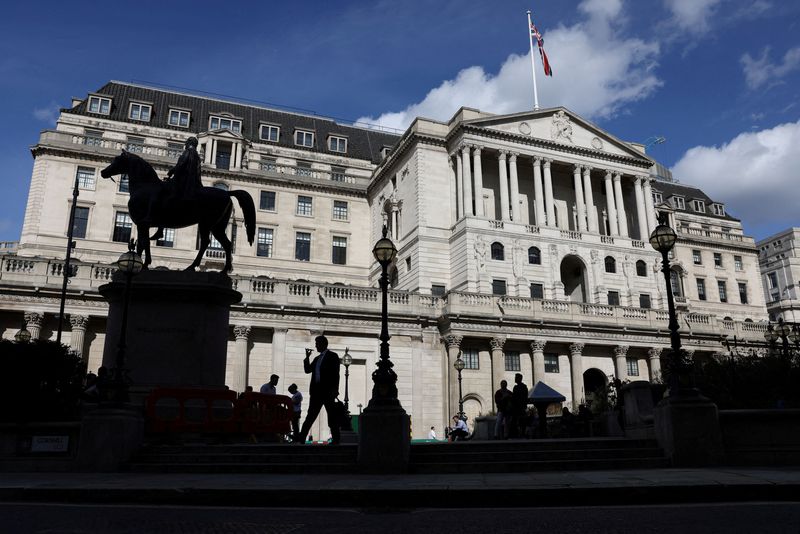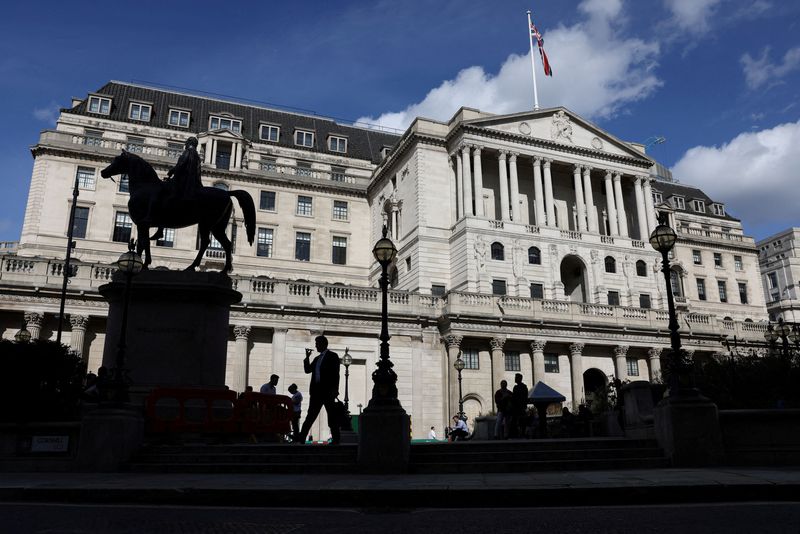Economy
Bank of England keeps rates at 15-year high, gilts rally


© Reuters. FILE PHOTO: A pedestrian walks past the Bank of England in the City of London, Britain, September 25, 2023. REUTERS/Hollie Adams/File Photo
LONDON (Reuters) -The Bank of England held interest rates at a 15-year peak on Thursday, as it kept up its fight against the highest inflation among the world’s big rich economies, and stressed that it did not expect to cut them any time soon.
The Bank Rate was held at 5.25% for the second meeting in a row after 14 back-to-back rate increases and the BoE published forecasts showing the British economy is now skirting close to a recession.
MARKET REACTION:
STOCKS: Britain’s benchmark held onto its earlier gains and was last up 1.26% on the day.
FOREX: Sterling was up around 0.5% at $1.2208. It was trading around 0.35% higher before the BoE decision at $1.2193. It dropped versus the euro, which was 0.37% higher at 87.31 pence.
Bonds: Benchmark 10-year UK bond yields were last down 16 basis points (bps) on the day at 4.33%, extending earlier falls.
MONEY MARKETS: Markets moved to fully price in a 25 basis point BoE rate cut by August 2024, earlier they had seen around a 80% chance.
COMMENTS:
GEOFF YU, SENIOR EMEA MARKET STRATEGIST, BNY MELLON, LONDON:
“The BoE is probably along the path that it expected and probably slightly frustrated that it is not further along.”
“If you want to take just one key phrase from the BoE’s Monetary Policy Report it’s judgement three – ‘Second-round effects in domestic prices and wages are expected to take longer to unwind than they did to emerge’. That means that the path down will be slow.”
“The moves in bond markets yesterday did a lot of work for them already. People are talking about getting back into bonds, including longer dated bonds, and that’s fair enough, the UK is probably in an OKish place there.”
ALTHEA SPINOZZI, SENIOR FIXED INCOME STRATEGIST, SAXO BANK, COPENHAGEN:
“Regarding the Bank of England, the projections paint a picture of stagflation, and signal the next move to be a cut in the base rate rather than a hike. However, investors will need to deal with the fact that inflation will not revert to 2% until 2025. That means that the long part of the yield curve will remain vulnerable to a bull steepening, as the BoE is forced to remain on hold.”
“The risk the BoE is running into is that, if at the next projections there is the need to revise inflation up again, that will need to be brought together with another interest rate hike. That would kill the central bank’s credibility at the cost of sterling.”
ED HUTCHINGS, HEAD OF RATES, AVIVA INVESTORS, LONDON:
“With no change but close to 0.75 (percentage points) of cuts priced for 2024, the BoE seems keen to push back on markets getting carried away with cuts.”
“With the lagged effects of past interest rate hikes still to feed through to the economy, weaker growth should well be expected going forward. This should largely be supportive for the currency, but elsewhere, the direction of travel on gilt yields in the near-term is more unclear.”
DARIO PERKINS, MANAGING DIRECTOR, GLOBAL MACRO, TS LOMBARD, LONDON:
“I think all central banks are sort of desperate to stop. The tightening cycle is basically over as far as I can see. If you look globally, you can see that some central banks have already started to ease so that sort of synchronized tightening that we had, has ended and now it’s just a question of when and if they cut interest rates.”
“I think the Fed is in quite a comfortable position, I’m not sure you can say the same about the Bank of England and the ECB.”
SAMUEL ZIEF, HEAD OF GLOBAL FX STRATEGY, J.P. MORGAN PRIVATE BANK, LONDON:
“The BoE told us that further tightening requires fresh evidence of inflation persistence. Data since the last meeting has not met that threshold.”
“They’ll likely be sitting on ‘Table Mountain’ for a while, but in our view the next move for the BoE will be to lower rates. The BoE evidently doesn’t disagree; its forecasts see inflation returning to target in 2025 if rates remain unchanged into next year and then gradually decline.”
“With the BoE in hand after the Fed yesterday and the ECB last week, all of the major central banks are now on hold in our view. At the same time, growth and inflation – particularly in Europe – are both moving in the same direction: lower. That’s a strong backdrop for fixed income; we like owning European bonds across the curve and funding tactical FX trades out of euro and sterling.”
CHRIS BEAUCHAMP, CHIEF MARKET ANALYST AT IG GROUP, LONDON:
“The BoE has struck a similar tone to the Fed, and today’s 6-3 result shows that caution is spreading to central banks outside the U.S. While it’s still clear that rate cuts are off the table for the foreseeable, it seems the bar for another rate hike has been raised a little today”.
MICHAEL FIELD, SENIOR EQUITY STRATEGIST AT MORNINGSTAR, AMSTERDAM:
“This will come as some small relief for markets, but any positivity coming from this announcement today has been lost in the euphoria on the news that the U.S. Federal Reserve is likely finished with rate increases, which should buoy the global economy.”
“That the Bank (of England) could also be finished with rate rises, and may even start cutting early next year, is something to be celebrated, both by businesses and cash-strapped mortgage holders. But at the same time, it is easy to forget how quickly and strongly rates rose. At 5.25%, base rates stand at their highest level since before the financial crisis.”
JEREMY BATSTONE-CARR, STRATEGIST, RAYMOND JAMES, FRANCE:
“Soft economic activity and inflationary pressures persist, but the fact that these are no worse than forecast contributed to today’s conclusion to hold the rate steady. The rise in longer dated government bond yields, in large part the consequence of global factors, has served to tighten financial conditions and done a share of the MPC’s (Monetary Policy Committee) work for it.”
“The question going forward is how long this standstill will last for – with financial markets expecting it to be a considerable period of smooth sailing. The door for future rate hikes still sits ajar, and the MPC will likely remain vigilant for further fluctuations and risks in the months ahead.”
PETER DOHERTY, DIRECTOR, HEAD OF INVESTMENT RESEARCH, ARBUTHNOT LATHAM, LONDON:
“Of all the major central banks, the BoE has the toughest path forward. Economic data is cooling, the labour market is tight, but inflation is still sticky.”
“In the short to medium term the ability of the (U.S.) Federal Reserve to hike relative to the BoE constrains the pound against the dollar.”
“When you look back a couple of months, what was priced in was continued hikes from the BoE and cuts next year from the Fed. What might turn out could be very much the opposite of that.”
GEORGINA TAYLOR, FUND MANAGER AND HEAD OF MULTI-ASSET STRATEGIES, INVESCO, LONDON:
“Given we are probably at peak rates, we have to line up the central banks in terms of who might move to cuts and we think probably the Bank of England will need to be the one major central bank that moves first. They need to focus on the growth-inflation mix and the fact the economy is deteriorating.”
“Across bond markets, gilts are the place where there is probably most value coming through so we have added some exposure.”
Economy
Russian central bank says it needs months to make sure CPI falling before rate cuts -RBC


© Reuters. Russian Central Bank Governor Elvira Nabiullina attends a news conference in Moscow, Russia June 14, 2019. REUTERS/Shamil Zhumatov/File Photo
MOSCOW (Reuters) – Russia’s central bank will need two to three months to make sure that inflation is steadily declining before taking any decision on interest rate cuts, the bank’s governor Elvira Nabiullina told RBC media on Sunday.
The central bank raised its key interest rate by 100 basis points to 16% earlier in December, hiking for the fifth consecutive meeting in response to stubborn inflation, and suggested that its tightening cycle was nearly over.
Nabiullina said it was not yet clear when exactly the regulator would start cutting rates, however.
“We really need to make sure that inflation is steadily decreasing, that these are not one-off factors that can affect the rate of price growth in a particular month,” she said.
Nabiullina said the bank was taking into account a wide range of indicators but primarily those that “characterize the stability of inflation”.
“This will take two or three months or more – it depends on how much the wide range of indicators that characterize sustainable inflation declines,” she said.
The bank will next convene to set its benchmark rate on Feb. 16.
The governor also said the bank should have started monetary policy tightening earlier than in July, when it embarked on the rate-hiking cycle.
Economy
China identifies second set of projects in $140 billion spending plan


© Reuters. FILE PHOTO: Workers walk past an under-construction area with completed office towers in the background, in Shenzhen’s Qianhai new district, Guangdong province, China August 25, 2023. REUTERS/David Kirton/File Photo
SHANGHAI (Reuters) – China’s top planning body said on Saturday it had identified a second batch of public investment projects, including flood control and disaster relief programmes, under a bond issuance and investment plan announced in October to boost the economy.
With the latest tranche, China has now earmarked more than 800 billion yuan of its 1 trillion yuan ($140 billion) in additional government bond issuance in the fourth quarter, as it focuses on fiscal steps to shore up the flagging economy.
The National Development and Reform Commission (NDRC) said in a statement on Saturday it had identified 9,600 projects with planned investment of more than 560 billion yuan.
China’s economy, the world’s second largest, is struggling to regain its footing post-COVID-19 as policymakers grapple with tepid consumer demand, weak exports, falling foreign investment and a deepening real estate crisis.
The 1 trillion yuan in additional bond issuance will widen China’s 2023 budget deficit ratio to around 3.8 percent from 3 percent, the state-run Xinhua news agency has said.
“Construction of the projects will improve China’s flood control system, emergency response mechanism and disaster relief capabilities, and better protect people’s lives and property, so it is very significant,” the NDRC said.
The agency said it will coordinate with other government bodies to make sure that funds are allocated speedily for investment and that high standards of quality are maintained in project construction.
($1 = 7.1315 renminbi)
Economy
Russian central bank says it needs months to make sure CPI falling before rate cuts -RBC


© Reuters. Russian Central Bank Governor Elvira Nabiullina attends a news conference in Moscow, Russia June 14, 2019. REUTERS/Shamil Zhumatov/File Photo
MOSCOW (Reuters) – Russia’s central bank will need two to three months to make sure that inflation is steadily declining before taking any decision on interest rate cuts, the bank’s governor Elvira Nabiullina told RBC media on Sunday.
The central bank raised its key interest rate by 100 basis points to 16% earlier in December, hiking for the fifth consecutive meeting in response to stubborn inflation, and suggested that its tightening cycle was nearly over.
Nabiullina said it was not yet clear when exactly the regulator would start cutting rates, however.
“We really need to make sure that inflation is steadily decreasing, that these are not one-off factors that can affect the rate of price growth in a particular month,” she said.
Nabiullina said the bank was taking into account a wide range of indicators but primarily those that “characterize the stability of inflation”.
“This will take two or three months or more – it depends on how much the wide range of indicators that characterize sustainable inflation declines,” she said.
The bank will next convene to set its benchmark rate on Feb. 16.
The governor also said the bank should have started monetary policy tightening earlier than in July, when it embarked on the rate-hiking cycle.

 Forex2 years ago
Forex2 years agoForex Today: the dollar is gaining strength amid gloomy sentiment at the start of the Fed’s week

 Forex2 years ago
Forex2 years agoHow is the Australian dollar doing today?

 Forex1 year ago
Forex1 year agoUnbiased review of Pocket Option broker

 Forex2 years ago
Forex2 years agoDollar to pound sterling exchange rate today: Pound plummeted to its lowest since 1985

 Cryptocurrency2 years ago
Cryptocurrency2 years agoWhat happened in the crypto market – current events today

 World2 years ago
World2 years agoWhy are modern video games an art form?

 Stock Markets2 years ago
Stock Markets2 years agoMorgan Stanley: bear market rally to continue

 Economy2 years ago
Economy2 years agoCrude oil tankers double in price due to EU anti-Russian sanctions

































